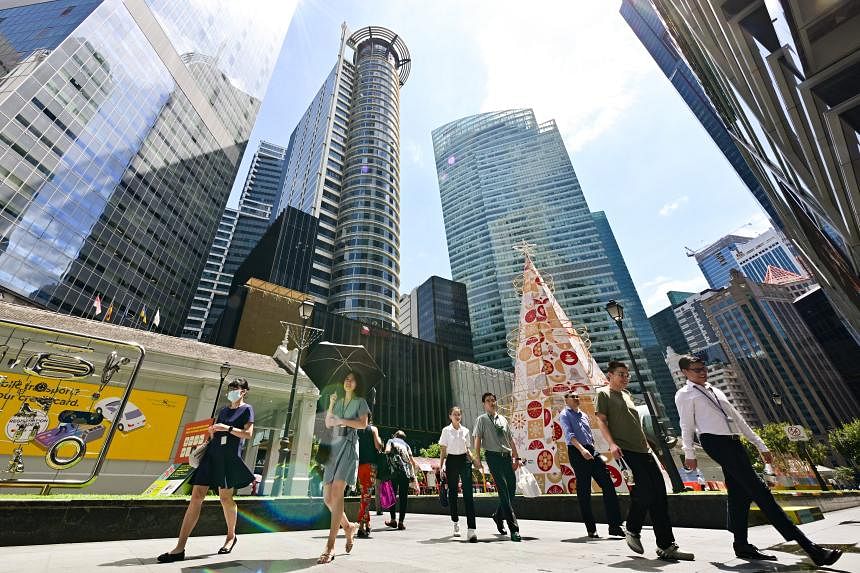SINGAPORE - Singapore’s total employment grew by 88,400 in 2023, largely driven by employment growth among foreigners. The increases came mainly in construction and manufacturing for foreigners, and in financial services and professional services for residents.
The Ministry of Manpower (MOM) noted in a labour market report for the fourth quarter of 2023, released on March 14, that the growth came as the employment rate for residents – Singaporeans and permanent residents – remains high, while the resident unemployment rate remains low at 2.8 per cent.
It also confirmed a January preliminary report that retrenchments in 2023 more than doubled from the previous year, with the figure finalised a tad higher at 14,590.
DBS Bank economist Chua Han Teng noted that while overall employment growth, excluding migrant domestic workers, expanded for the ninth straight quarter by about 7,500 in the last three months of 2023, this was the slowest pace of growth since the third quarter of 2021.
Associate Professor Walter Theseira, a labour economist from the Singapore University of Social Sciences, put the recent numbers down to the labour market coming off the post-pandemic boom.
“There was a very tight labour market immediately after the transition to a post-Covid framework as everything opened up, which meant your retrenchments and unemployment were low,” he said.
“But the post-Covid economy also transitioned globally into a general restructuring as many firms, especially in the tech sector, realised that the business model they used for hiring during Covid didn’t make sense anymore.”
Meanwhile, the number of job vacancies registered a slight increase in December 2023 to 79,800 after six consecutive quarters of decline.
According to MOM, higher-paying sectors such as financial and insurance services and professional services saw an increase in job vacancies – from 5,100 to 7,200 and from 5,600 to 6,200, respectively.
Other growth sectors include health and social services.
It added that while the information and communications sector saw a decline from 7,100 to 6,300 vacancies, the number remained higher than the pre-pandemic level. The average number of vacancies for the sector between December 2015 and 2019 was 3,400.
With the rise in job vacancies, the ratio of job vacancies to unemployed people also rose to 1.74 in December 2023. There have been more job vacancies than job seekers since 0.96 in March 2021, indicating a moderately tight labour market.

The ministry also said there was a decline in the proportion of workers who were able to secure employment within six months of their retrenchment.
In the fourth quarter of 2023, a total of 61.5 per cent of retrenched workers re-entered the workforce within six months of being laid off, compared with 65.3 per cent in the previous quarter.
However, MOM said this could be due in part to the fact that a higher proportion of affected workers were aged 50 and above, adding that this segment of the workforce generally takes a longer time to find new jobs.
While there has been a slowdown in the re-entry rate, about 75 per cent of workers were able to find new jobs within a year, said the ministry.
Commenting on the data, Mr Chua said re-entry rates declined in outward-oriented sectors due to external headwinds faced by Singapore’s economy in 2023.
He added: “Notably, the re-entry rate of mature workers aged 40 and above stayed below the overall rate, registering at 54.6 per cent in 2023. In this regard, the new SkillsFuture Level-Up Programme announced in Budget 2024, targeted at Singaporeans aged 40 and above, can help impacted mid-career and mature workers to update their skills and remain relevant amid a disruptive economic environment.”
Associate Professor (Practice) Terence Ho from the Lee Kuan Yew School of Public Policy at the National University of Singapore also said that the Budget measures on skills upgrading could help more workers to switch careers if needed, which will make for a more resilient workforce and labour market.
Mr Ang Boon Heng, director of MOM’s manpower research and statistics department, said a majority of retrenched workers find jobs in new industries, and now receive similar or higher wages.
Around six in 10 of residents who found work in a different industry in 2023, within six months of being laid off, received similar or higher wages in their new jobs, said MOM’s report. It also said the increased amount of time needed for residents to find new jobs in 2023 could be attributed to the higher share of workers who switched industries, as these workers generally take longer to find suitable jobs.
Declining re-entry rates might become a longer-term trend, noted Prof Ho. He said: “I would expect the re-entry rates to trend downwards over time as the proportion of professionals, managers, executives and technicians, particularly older PMETs, in the workforce increases. These workers tend to have higher expectations, and it may be harder to find a job with a good skills match once they have been displaced.
“It will take longer (for them) to get back into employment, particularly if they have to retrain for a new sector or industry.”
Looking foward, MOM said firms may continue reorganisation or restructuring efforts as downside risks in the global economy remain. Still, it expects labour demand to strengthen, in line with the forecast of improved economic growth prospects for 2024.
“While retrenchments may edge up in 2024, we expect (the) majority of retrenched residents to re-enter employment within six months as job vacancies remain available, and forward-looking indicators suggest improved hiring expectations among employers,” it said.
Prof Ho said that the labour market in Singapore looks to be normalising.
He said: “The effects of Covid-19 on the labour market have been felt for several years where labour demand has been sky-high relative to supply, as reflected in exceptionally high job vacancy rates along with low retrenchments. We are now seeing a reversion to more normal labour market conditions.”
“We can be cautiously optimistic, as Singapore’s economic growth this year is expected to be higher compared with last year. And business sentiments in regard to hiring and wages have improved in the fourth quarter.
“Given these trends, I’m hopeful that the labour market will remain fairly tight this year provided there are no major adverse economic shocks.”


